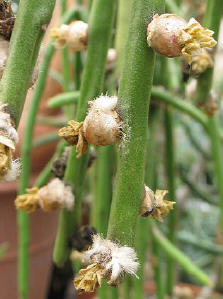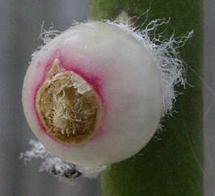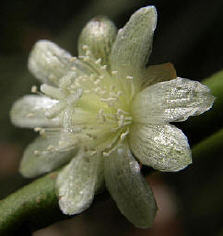|
R. floccosa subsp. tucumanensis (F A C Weber) Barthlott
and N P Taylor in Bradleya 13 (1995) |
|
|
Desc from B&R 1923 Type
locality: Tucuman, Argentina.
Notes from Bradleya 13 DISTRIBUTION. Eastern Andes of Peru (Junin), Bolivia (La Paz, Santa Cruz, Tarija), Argentina (Jujuy, Salta, Tucuman, Catamarca): epiphyte, at 700-1725 m altitude. Like subsp. pulvinigera, but stems less reddened and fruits larger, to 10 mm diam., red or white. Like subsp pulvinigera, but stems less reddened and fruits larger, to 10 mm diam., red or white. Rhipsalis tucumanensis Weber, Rev. Hort. 64: 426. 1892 Translated by Luc Scherens 12/20038. Rhipsalis tucumanensis, Web. - Belongs to the section of Rhipsalis with sunken ovary, with floccose areoles. Sent in 1885 by M. Schickendantz from the environment of Tucuman (Republic Argentina). Found in company of Rh. lumbricoides and aculeata. Also gathered by M. Niederlein at Alpachiri (province of Catamarca) and mentionned by Dr. Schumann (Flora Brasil., page 284) as a form of Rh.pentaptera. Specimens I have received in 1885 were half dried and completely angular, like Rh. pentaptera. Very robust species, long, climbing or hanging, 6 to 10 mm thick, having theappearance of Rh. funalis and floccosa, but longer, cilindrical or angularfrom the moment it's a little bit dehydrated. Green epidermis, not wrinkled; very few side branches, lateral, getting narrower towards the extremities. Flower bearing areoles floccose. Non flowering areoles with a large red orbrown scale. Flowers solitary, surrounded by a big tuft of wool, white, open, 15 to 18 mmin diameter. Ovary immerged. Sepals 4, rounded, white, with a rose tone onthe back side. 8 Petals, lanceolate-oval, white, veined, with pinkextremities. Stamen 50 to 60, white, widely spreading, insertedin a white disk, projected by the style. Style white, slightly depassing thestamen, ended by 4 to 5 stigmata, thick, velvet, curling back. The flower doesn't have the yellow tone like with Rh. floccosa, from whichit's distinguished by the rose tone on the sepals and the extremities of thetepals. Berry big, 8 to 10 mm in diameter on 7 mm high, globoid (flattened spherical),waxy or porcelain white with a pink or fleshy tone, surrounded at its baseby the areole wool and crowned by the dried flower remains. Containing 20 to 30 seeds, smooth, brown, shiny, allongated, 1,2 mm long, 0,8 mm wide. Sub basichilum oblique, quite big, white. Rapid germination (8 days). Germen green, cotyledons pointy, curving back.
|


